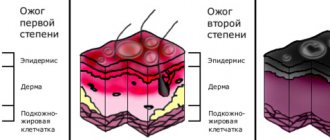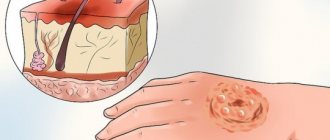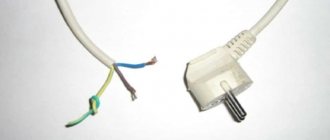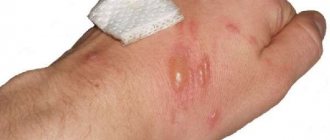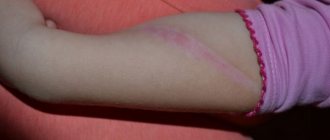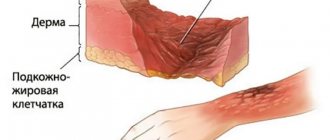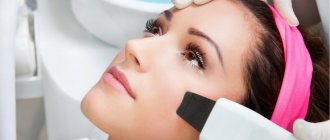According to the burn center of the children's city clinical hospital No. 9 named after. G.N. Speransky in Moscow, burns rank third in terms of injuries, with children accounting for ¾ of all cases. Most often, burns occur in young children under 5 years of age. Thermal burns in children occur more often than chemical and electrical burns.
Children's skin is much more delicate than adults, so any burn, even minor, can cause significant harm. Therefore, you should definitely consult a doctor about how to treat a burn in a child.
Types of burns
Thermal burns in children most often occur at home.
Children can be scalded by boiling water, burned near a fire, on a stove or an iron. Even too hot water during bathing can injure delicate skin. Electrical burns account for about 4% of injuries. Chemical burns occur even less frequently and are usually associated with parental carelessness when storing household chemicals.
In summer, you should pay close attention to sunburns: they are not as harmless as they seem. It is necessary to have special means on hand and know what to apply to a child’s burn in order to minimize the negative consequences. But first of all, it is important to quickly take him to a cool place, in the shade.
Electrical burn
Children get electrical burns when they come into contact with faulty household electrical appliances, when trying to insert foreign objects into an outlet, and so on.
If a child is injured by an electric shock, the first step is to break the contact of the victim with the electrical source. Trying to simply pick up the baby in your arms can lead to the mother being exposed to the current. In this case, it is necessary to push the child aside.
When examining your baby, remember that electric current has an entry point and an exit point. If you notice a burnt point on the handle (presumably the entry point), then be sure to find the exit point as well. The damaged areas should be covered with a sterile bandage.
A feature of an electrical burn is the relative integrity of the outer skin and serious injury to internal tissues (nerves, blood vessels, muscles). The extent of damage is difficult to determine visually.
It is very important to monitor the heartbeat and breathing of a child with an electrical burn, as the shock can change the heart rate. The child must be shown to the doctor immediately, and he must be transported lying down.
Precautionary measures:
- Cover all sockets with special plugs
- Don't let your baby play with electrical appliances
What types of burns are there?
Burns are classified by degree (see photo). The severity of the injury depends on the area and depth of the injury.
First degree burns (superficial)
Not considered dangerous. They are characterized by redness of the skin, slight swelling, and sharp pain. The consequences of the injury disappear without a trace within a few days.
Second degree burns (medium thickness)
Damage to the upper layer of skin, which is manifested by swelling, hyperemia of the skin, and the appearance of blisters with transparent contents. With proper treatment of burns in children, the consequences of the injury disappear within 2-3 weeks.
Severe burns (third degree and fourth degree)
May pose a danger to the child's life. With such damage, the skin is affected to its full depth; subcutaneous fat, soft tissue, tendons, and bones may be affected. It is necessary to seek medical help as quickly as possible. Severe burns are treated only in specialized departments of clinics.
Depending on the extent and area of damage, treatment and rehabilitation may take many months.
What is a thermal burn?
Thermal burn
is a burn that is caused by contact with a liquid, solid or gaseous heat source. Such a heat source can be hot bodies, flames, steam, or hot liquids. The first place in statistics is occupied by flame burns (about 84% of all thermal burns), followed by burns with liquid substances and electrical burns (approximately 7% for each type). In 2% of victims, burns were caused by other factors.
A thermal burn can damage several layers of skin at once: epidermis (outer layer), dermis, subcutaneous tissue. Depending on the number of damaged layers, four degrees of thermal burns are distinguished. Often a burn includes all these degrees at the same time. Many doctors, when describing burns, classify them according to the depth of the damage: superficial, partial, complete.
The severity of the burn also depends on the area of the affected tissue. It is expressed as a percentage relative to the area of the entire surface of the skin. When roughly assessing a burn, the so-called “palm rule” is used: the area of the human palm is equal to one percent of the body area.
Degrees of thermal burns
It is customary to distinguish four degrees of burns depending on the depth and severity of the injury. Burns of the 1st and 2nd degrees are considered superficial, 3rd and 4th - deep.
- First degree thermal burn
The affected area swells and turns red. A person is disturbed by pain and burning, especially acutely felt when touched. The skin temperature in the affected area increases. The listed symptoms last for 2, sometimes 3 days, gradually disappearing. The burn site continues to disturb the victim for some time; the epidermis begins to peel off. Gradually (after 3-5 days) the injured area looks almost healthy. - Thermal burn of the second degree
This burn occurs due to prolonged or sudden exposure to high temperature. There is also redness and swelling of the tissues, but blisters also form. They are filled with tissue fluid exuding from dilated skin vessels. Later, the contents of the blisters, due to protein coagulation, turn from a transparent mass into a jelly-like mass containing leukocytes. The tissue fluid and the skin of the blisters themselves protect the tissues located under the lesion from injury and infection; for this reason, the blisters cannot be opened. Patients with a second degree burn typically suffer from severe pain. But after a few days, tissue irritation and circulatory disturbance begin to decrease, and the liquid is gradually absorbed. At the bottom of the blisters, epidermal cells are actively dividing, and after a week a new stratum corneum begins to appear. - Third degree thermal burn
It occurs during prolonged exposure to high temperature. It is characterized by skin necrosis - tissue necrosis, which can be dry or wet. When tissue is exposed to steam or boiling water, wet necrosis usually occurs. The skin becomes swollen, pasty, acquires a yellowish tint, and may become covered with blisters. This inflammation occurs in a manner similar to the melting of dead tissue. When necrosis is dry, the skin is also dry, dense, dark brown or black. The edges of the area with dead tissue are clearly visible. Healing of burns of this degree occurs through scarring. However, when at least small areas of the germ layer of the epithelium are preserved, epithelization cannot be ruled out. - IV degree thermal burn
This is, without exaggeration, the most terrible degree of burns. Often such burns cover a large area. All layers of the skin and even tissues located outside it die: subcutaneous fat, tendons, muscles, bones. Several large blisters often merge into one huge one; the skin color becomes dark red, reaching black. Such damage threatens not only human health, but also human life. III and IV degree burns are, of course, more dangerous, but superficial burns can also be fatal if they involve more than a third of the body surface.
First aid for thermal burns
- The first thing to do as quickly as possible is to extinguish the flame (if there is one) on the victim’s clothing and skin. It is necessary to throw off burning clothes from a person or throw a cloth over his body to stop the access of air to the fire. A burning area of clothing can be covered with earth, sand, snow, or doused with water.
- Try to calm the victim and the people around him.
- Carefully remove from the injured person any smoldering remains of things that do not get into the wound. Under no circumstances should you remove clothing that is stuck to a burn. You should also not touch the burned body with your hands.
- If it is a sunburn, you need to move the affected person to the shade.
- If you do not have information about what happened, quickly clarify the circumstances of the accident (“the child knocked over a bowl of hot broth,” “clothes caught fire from the fire,” etc.).
- Hold the affected part of the body for 10-20 minutes under running cold running water (you can put it in a container with cool, clean water). This must be done so that the heated wound does not deepen or expand. In addition, it activates blood circulation in the wound. However, ice should not be used to cool the burned area to avoid the possibility of another injury - frostbite. In extreme cases (if there is no water nearby), cooling the wound with urine is allowed, but in practice there is almost never a reason to use this method.
- Apply any available anti-burn agent (ointment, gel) to the affected surface, and apply a sterile (if possible) dry bandage on top. You cannot use cotton wool, only gauze, bandages - fabric materials. It happens that you have neither anti-burn agent nor sterile bandages at hand, then you should apply any dry, clean bandage to the wound. You should not apply any folk remedies to the burn: vegetable oil, vodka solutions, kefir, sour cream, etc. You should also not apply Kalanchoe or aloe leaves or other “miracle remedies” to the burned skin. In case of a first degree burn (if there is no extensive damage to the skin or blisters), a bandage may not be applied at all, only an anti-burn gel can be applied.
- If there are extensive burns of the extremities, you need to carefully fix them with a splint (any available means), raising the burned arms (legs).
- If a large area of the body is burned and there are signs of burn shock (the person is weak, pale, has increased anxiety, there is tachycardia and a drop in blood pressure, cold sweat, breathing and heart rate are disturbed), you should give him as much liquid as possible to drink - juice, compote or plain clean water. Thanks to the intake of fluid into the body, intoxication resulting from the penetration of decay products of burnt tissue into the blood will decrease.
- If the victim complains of pain, then in order to avoid painful shock, you should give him any available painkiller (spasmalgon, analgin, etc.).
- If a person has no cardiac and (or) respiratory activity, cardiopulmonary resuscitation (artificial respiration, chest compressions) should be performed.
- In case of severe burns, call an ambulance for hospitalization of the victim or independently deliver him to a specialized medical institution. It is preferable to use, since not everyone can accurately say in which hospital or department burns are treated. It’s good when it’s a specialized clinic or at least a specialized department.
Treatment of thermal burns
Treatment of patients who have received thermal burns should include a set of means aimed at correcting the disorders that appeared in the body due to the burn. Antishock therapy should be adequate to the stage of medical care, the severity of burn shock and the age of the victim. It should include the following activities:
- pain relief;
- replenishment of blood deficiency (its components);
- prevention, treatment of hypoxia;
- correction of water-electrolyte, protein metabolism and acid-base balance of the blood;
- fight against intoxication;
- compensation of the body's energy costs;
- prevention, treatment of heart disorders;
- prevention, treatment of acute hepatic-renal failure.
In a specialized clinic (specialized department), primary care of burns is performed under anesthesia. Gentle treatment of wounds and the skin surrounding them is carried out with gauze wipes soaked in warm soapy water or a 0.5% solution of ammonia. After this, the burn surface is carefully washed with warm water or alcohol (40-70 degrees), dried and irrigated with antiseptic solutions.
Very dirty burn areas are cleaned with a 3% hydrogen peroxide solution. Particles of the epidermis are removed from superficial burns with tweezers or scissors. Small blisters are not opened, but large detached blisters are cut at the base and then emptied by lightly pressing them with a gauze swab. For burns caused by tar or bitumen, use purified gasoline.
With the open method of treatment, a thin layer of a special ointment or another synthetic (biological) coating is applied to the surface of the wound. With a closed method of treatment, a bandage with a special ointment (synthomycin, streptomycin) or emulsion (for example, sulfidine) is applied to the burn. Vishnevsky's anti-burn oil-balsamic emulsion is also effective. Such dressings do not interfere with the healing of the burn, do not cause pain when changing, and provide high-quality protection of the wound from infection. The bandage is carefully bandaged, lightly pressing on the tissue. It should not move; if the disease progresses successfully, the bandage is not removed until 7-9 days. This period is enough for the burn surface to epithelialize.
If the limbs are burned, immobilization is required, i.e. temporary immobilization. Any position convenient for the victim can be selected. In order to avoid the negative consequences of immobilization, every 2-3 days it is necessary to pause immobilization in order to make movements in the joints.
There is no single correct opinion on what should be done with burn blisters. Some doctors quickly remove them, explaining that their internal contents are not sterile; other doctors release liquid from the blisters, but do not remove the blisters themselves.
To restore the body of a victim who has received a fourth-degree burn, prompt, competent treatment and skin grafting are required.
Forecast of thermal burns
Pathophysiological changes that inevitably develop in the body affected by a burn provoke disturbances in the vital systems of the body and even threaten human life. The prognosis largely depends on the area of the lesion, the extent of the lesion and the age of the victim. Mortality from burns is high in old people over 60 years of age and children under 3 years of age. However, even for patients of this age, burns cannot be considered a death sentence.
A critical condition is considered to be 100% - a total burn of the first degree, and burns of the second-third degree when more than a third of the body surface is affected. Life-threatening are third- and fourth-degree burns that affect the genitals, face, perineum (if they affect 10% of the body surface), and burns of the torso and limbs if the affected area is more than 15%. For more accurate predictions of burns, special methods have been developed - the “Rule of Hundreds”, “Frank Index”, which take into account the depth, extent of the affected area and the age of the victim.
You need to know: if the thermal effect on the skin lasts longer than 1 minute and exceeds 45 ° C, this inevitably leads to overheating of cells and their death due to inactivation of enzymes, protein denaturation, paralysis of tissue respiration and other metabolic disorders. After the cessation of thermal exposure, hyperthermia in the tissues does not stop, but continues and even becomes more active!
What to do for burns
First of all, it is necessary to stop the effect of the traumatic factor. In case of burns from boiling water in children, it is necessary to remove their wet clothes, being careful not to damage the blisters. Extinguish open flames with thick cloth. Do not pour water on the fire, as this creates steam, which can also burn the child or you. If your hair catches fire, for example when blowing out candles on a cake, you should also use a cloth to knock down the flame to prevent it from spreading.
In case of a slight burn in a child (1-2 degrees), if possible, cool the injured area under running cold, but not ice-cold water, at a temperature of approximately +10...+20 ℃, or cover the burn site with a clean cloth moistened with water.
If the injury is mild, you can treat the burn site with a special spray. To reduce pain, you can give a mild over-the-counter pain reliever according to the age of the victim. It is necessary to calm and distract the child if possible.
A more severe burn should not be cooled with running water. It is necessary to call a doctor, cover the affected area with a clean cloth to prevent infection, give pain relief and wait for the doctors to arrive, or take the child to a medical facility yourself.
A burn in a child with blisters, how can it be treated?
Burns with a blister are treated at home only in cases where the extent of the damaged area does not exceed the size of the palm of an adult. If a child’s face, feet, hands, or vital organs are injured, treatment is carried out in an inpatient setting. Only if the affected areas have minor damage, the wound can be treated at home, both with medications and folk remedies.
A huge selection of medications allows you to choose a remedy that will have a wide range of effects, or combining them, in order to quickly restore the affected area.
How to treat a blister after a burn in a child
When selecting medications, experts first of all advise using complex effects. These are:
- Fastin. The drug is produced in the form of an ointment, which is used for newly formed 2nd and 3rd degree burns. The drug contains anesthesin, furatsilin and syntomycin, which have a disinfecting and analgesic effect.
- D Panthenol. Included in the group of reparants using dexpanthenol. The drug is a skin epithelial simulator with anti-inflammatory action.
- Argosulfan. Antibacterial cream ointment prepared on the basis of silver sulfathiazole, an active substance and antibiotic with a broad spectrum of action. The drug blocks the appearance and proliferation of bacteria, while simultaneously reducing allergic reactions.
- Solcoseryl. Prepared from calf blood extract, the drug perfectly restores skin cells damaged by burns. It is used to treat burns at various stages of development.
- Neosporin. Antibiotic with wound healing properties. It counteracts infections, blocks the action of bacteria, and is prescribed when there is a threat of scars. The drug contains three types of antibiotics: bacitracin, neomycin, polymyxin.
To this list of drugs you can add oflocaine, an ointment with analgesic and antiseptic effects, as well as a special material that is used when treating burn sites in the form of napkins (Activtex) and sterile dressings (Vescopran).
How to treat if a child’s blister bursts
In some cases, blisters have to be pierced, this is done carefully and in compliance with all safety rules: the object with which this is supposed to be done is processed to achieve sterility. It is important to know that the treatment of burns with blisters is not fundamentally different from ordinary ones:
- The wound is washed with running water.
- Treated with an antiseptic.
- Apply a layer of ointment with antibacterial and wound-healing properties.
- Cover the wound with a bandage, which is changed from time to time.
Treatment of minor burns lasts from 3 to 7 days, during which it is expected to replace one drug with another if the previously used one is not effective.
How to prevent
Most cases of childhood burns are the responsibility of parents and other adults who leave children unattended in potentially dangerous places. Therefore, when a child appears in the house, all family members must follow the following rules.
- Do not drink or eat hot food while the baby is in your arms.
- Cook food only on the far burners.
- Keep potentially dangerous objects as far away from the edge of the table as possible.
- When preparing a bath, turn on cold water first, and then hot, thoroughly mixing the layers. Remember that water at a temperature of +50 ℃ can be dangerous for a child!
- For sunbathing, use only early morning hours and use sunscreen.
- If possible, do not use extension cords; try to secure electrical wires and cords so that the child does not grab them if he falls.
- Keep electrical appliances as far as possible from children and water sources.
- Hide candles and matches.
- Keep household cleaning products and other chemicals out of the reach of children.
Safety regulations
- fence off the dangerous area (heater, ironing board with a hot iron, stove, etc.) with a safety gate with a door lock or, conversely, fence off a safe area where the baby can play;
- if the house has a fireplace, equip it with a fireplace grate;
- do not leave matches and lighters within the reach of children;
- place household appliances so that the baby cannot, under any circumstances, reach the back panel;
- equip the devices with a special protective device that protects it from accidental overturning by children;
- attach or hide the wires under the baseboard;
- Place extension cords behind furniture so that the child does not touch them and trip;
- cover the sockets with special protective plastic covers;
- periodically check that the wire insulation is not worn out
- keep household chemicals out of reach
Have you encountered similar problems? Please share your opinion and experience!
The article was prepared as part of the “Children are Safe” initiative of the project “Prevention of non-communicable diseases, promotion of healthy lifestyles and support for the modernization of the health care system in the Republic of Belarus” (“BELMED”), funded by the European Union and implemented by UNDP, WHO, UNICEF and UNFPA in partnership with the Ministry of Health of the Republic of Belarus. The publication does not reflect the official position of the EU and UNDP.
Author of the article Daria Sovina
comments powered by HyperComments
What not to do
If an accident does occur, it is important to quickly provide adequate first aid for a child’s burn. If you don’t have anything in your home medicine cabinet to treat your child’s burn, urgently take him to a doctor or call for medical help.
You should not tear off clothing that has stuck to the wound, touch the affected area, or open blisters that have formed - all this will cause severe pain to the child and will contribute to infection.
You cannot treat damage with folk remedies! It is better to do nothing than to anoint a child’s burn with oil, toothpaste, egg white, starch, soda, kefir, urine, non-specialized creams and ointments. This will not bring any benefit, but on the contrary, it may worsen the negative consequences.
When to call an ambulance
- the burn occurred in a child under 5 years of age;
- the face, groin area, hands, feet are affected;
- in case of electrical injury;
- the affected area is more than five palms of the child, in children one year old and younger - one palm;
- the child has chills, fever, and loss of sensitivity at the site of the lesion;
- if damage to the respiratory tract or eyes is suspected.
The sooner the victim is in the hands of doctors, the more effective the assistance provided to him will be and the higher the likelihood of a favorable prognosis.
When is it necessary to see a doctor?
Specialist intervention is necessary if:
- A child under one year old was injured
- The baby's upper respiratory tract or eyes
- The skin of the face , neck or head is injured
- The girl received a burn to the groin or chest
If something bad happens to your baby, first help him and calm him down, and only then think about what you did wrong and how to avoid this in the future.




